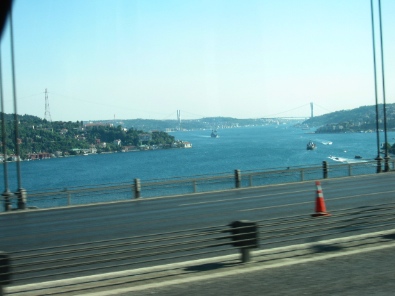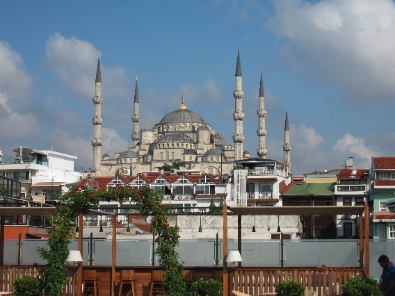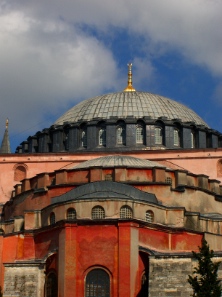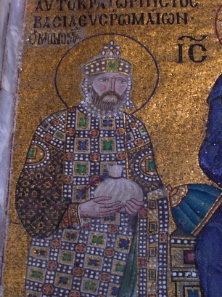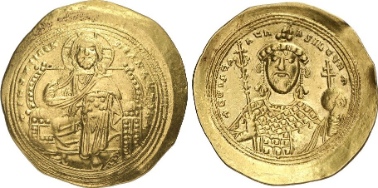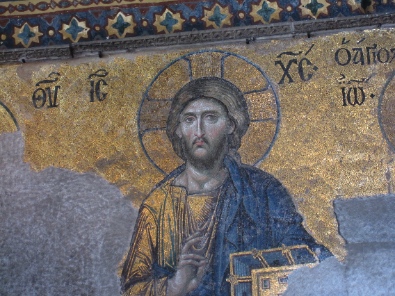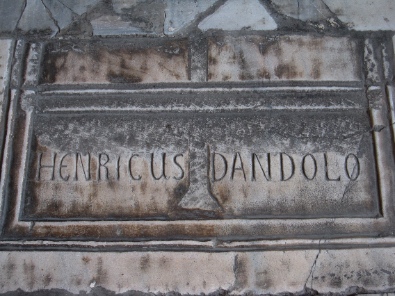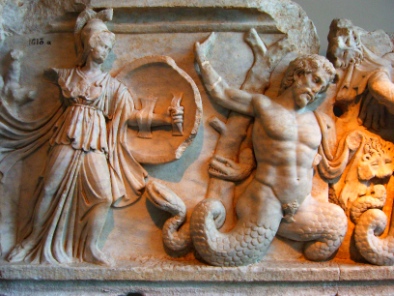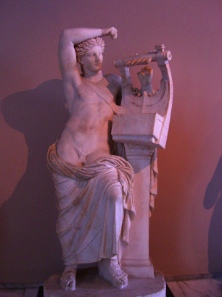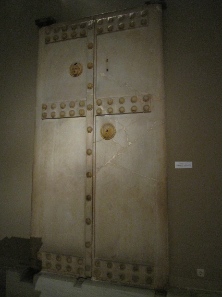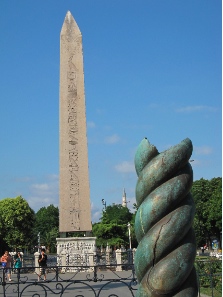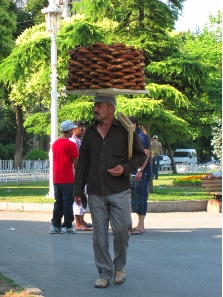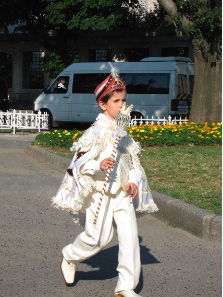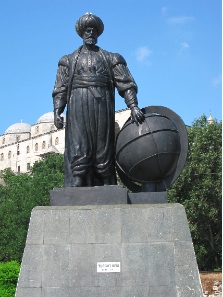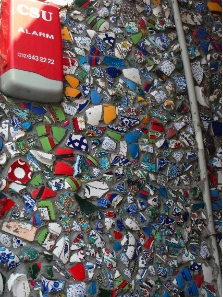April 5, 2012 – You don’t have to introduce Istanbul. Everyone knows the beautiful city at Bosporus River. This was our last stop on our journey across Turkey. After having been to areas with barely any touristic infrastructure it was almost a civilization shock to finally get anything again a tourist would wish.
Good Homes Turkish style: the passengers of the bus ride were collected in these densely populated suburbs. Photograph: KW.
July 1, 2009
We had decided to go to the otogar by taxi the next morning – that would be much easier than taking a taxi and then take the metro to finally arrive at the bus terminal. Everything went smoothly there. The nice hotel boy had mentioned two bus companies that would offer especially inexpensive bus rides at the moment, the bus driver drove right in front of the terminal to Istanbul and we hurried to exactly the right counter. The next bus was scheduled in 15 minutes – they are leaving for Istanbul at all times. In the beginning, we wondered why the bus was so empty; the miracle was solved when we approached the second stop, this time being in the middle of nowhere where only the company’s busses are running. Now the vehicle filled with people, crying children and luggage. It was filled to capacity – and then we departed, took the freeway and went on and on. Little by little I realized that ‘non-stop’ didn’t mean skipping the numerous stops on the way to fetch passengers but skipping the usual break for getting something to eat and use the toilet. For the latter purpose they had a toilet on board, a bus toilet, a rare luxury in Turkey and decently clean (the poor busboy not only had to supply the passengers with beverages but also to clean the toilet every time someone had used it).
Crossing Bosporus by bus. And there we were, back in Europe. Photograph: KW.
The bus staff argued where exactly we should get off the bus in Istanbul. There were four official stops to choose from. Having arrived at the third, the attendant ordered us to dismount. We fetched our luggage, stood there all dressed up and nowhere to go before a local bus employee got us on the bus again. It would be better for us to go to the last stop! I don’t know if that stop was better located strategically but the arrival was an experience. This otogar was even bigger than the one in Ankara, but couldn’t be accessed by a simple entrance; one had to go through the subterranean realms of the huge multi-storey building first. Being in the underworld of the French Opera would have been no different: spooky vaults with high ceilings, scattered people doing their work far away from daylight, ramshackle busses and scrap, you could see everything from the window.
The hotel was a revelation! We had returned to the civilized world! They had a magnificent lobby and an attentive porter who spoke German (with a slight Berlin accent) plus marvelous rooms with sea view. Only the shower had that typical Turkish touch: terrific shower head, marble floor, but the shower partition was 10 centimeters too short at its lower end so that it can’t be helped: after showering the bathroom was flooded until the next visit of the cleaner (the shower tub, in contrast, was dry already half an hour later, but there the water drained off…).
The Blue Mosque. Always beautiful. Photograph: KW.
Of course we went into town, to the Blue Mosque. This is Kurt’s favorite spot. He likes to sit opposite to the building and look at the cupolas bulging on top of another so magnificently. Naturally we were spoken to while sitting there. But the man was polite and he didn’t seem to have a carpet shop (well, in fact he did, but he wasn’t pushy), and so we chatted a little bit about Turkey, Istanbul, the Turks and life in general. We didn’t let ourselves dragged to the carpet shop but went on our own through the gate of the mosque’s inner courtyard, not without being said goodbye to in perfect Zurichdytch.
A small dinner close by the mosque – not particularly good but the more pricy – and back we were, in the tourist world. Istanbul is simply gorgeous!
View from the breakfast terrace of Armada Hotel. Photograph: KW.
July 2, 2009
The next morning we faced a surprise. The breakfast terrace offered a view at the Bosporus River on the one side and a view at the Blue Mosque and the Hagia Sophia on the other. Simply incredible! And, in addition, a breakfast buffet we hadn’t come across the entire four weeks before – there was nothing American there, only Turkish: several varieties of goat cheese and olives, fruit – fresh and dried (even dried mulberries) –, comb honey!!!, small filled turnovers, halva and other sweets, several kinds of jam, cai – only the Turkish coffee we had to order, but we were served it without the slightest problem.
Hagia Sophia. Photograph: UK.
First we went to the Hagia Sophia, like thousands of other tourists. It is amazing how this gorgeous building keeps it dignity despite the countless visitors. The imperial mosaics at the gallery are impressive – sometimes you even stand there, in front of the works of art, for one or two seconds all by your own. We spent almost two hours here to have a close look at all the details.
Constantine IX, 1042-1055. Photograph: KW.
Of course, most impressive were the mosaics of the Byzantine emperors, mainly because their facial features are so familiar from the images on the coins.
Constantine IX Histamenon. Rev. Emperor with labarum and globe cruciger. From auction Gorny & Mosch 203 (2012), 621.
There it is, the crown circlet with the small cross on top of fit and the pendilia hanging down the temples. The garment, decorated with squares, can be explained. Instead of labarum and globe cruciger the emperor is holding a moneybag whose string is of course sealed with a lead seal.
Christ Pantocrator, right hand elevated to give His blessing, book in the left. Photograph: KW.
The depiction of enthroned Christ Pantocrator we have seen any number of times on coins as well: the bearded, calm face, surrounded by a halo with a cross; the right hand elevated to give His blessing, holding the Gospel in the left.
Grave marker of Enrico Dandolo, Doge of Venice. Photograph: KW.
And of course we would like to recall the grave marker of Doge Enrico Dandolo, driving force behind the sack of Constantinople in 1204.
Depiction of the Kaaba inside Hagia Sophia. Photograph: UK.
Of high historical importance are these tiles showing the Kaaba of Mecca which indicates that the ban on images wasn’t rigidly enforced at all times.
The mysterious cistern – unfortunately, it was overcrowded with people. Photograph: KW.
From the Hagia Sophia we headed for the Basilica Cistern which has become a well marketed site of the city. They play music in order to create a mystical atmosphere despite the crowds of people barging their way on the wooden footbridges. Unfortunately, we ran into a Turkish scout meeting with lots of youth groups taking photographs of each other in front of the various columns. At some point, we left the scenery, being annoyed, to sit down in the subterranean café, had the most expensive water of the entire stay and decided to go to the Archaeological Museum.
Gigantomachy. Relief from Aphrodisia. Photograph: KW.
And that was truly amazing. 20 years ago, I had seen just one or two rooms, the rest was closed, and now it took hours for us to have a proper look at everything – and it was excellently presented (by Turkish standards).
Apollon Kitharoedos from Miletus / present-day Turkey. Photograph: KW.
So-called Alexander Sarcophagus, discovered in Sidon / present-day Lebanon. Photograph: KW.
Marble entrance to a tomb, discovered near Thessaloniki / present-day Greece. Photograph: KW.
Grave stele of a gladiator from Tralleis. Photograph: KW.
The room with the sepulchral inscriptions from all over Turkey was particularly terrific: translations of the inscriptions in Turkish and English everywhere, historically fascinating objects, I was truly enthralled. Coins? You won’t find any in Istanbul; apparently they have to be confiscated in Switzerland to convince the Turks of exhibiting them at all.
View at the Serpent Column and the Obelisk – the last remains of the Hippodrome. Photograph: KW.
Then we had seen enough. We sat down peacefully on a bench in the Hippodrome and just watched Turkish daily-life.
Simit sellers. Photograph: KW.
There were the simit sellers…
Prior to circumcision. Photograph: KW.
…and the little princes, being happy until they were led to being circumcised.
In the previous weeks, we had seen enough to not hurry to the next attraction all the time.
Statue of Turgut Reis, an important Ottoman admiral who had raided Italy a couple of times. His statue is standing in front of Topkapi Serail today. Photograph: KW.
July 3, 2009
The last day of our vacation started with an endless walk near the Byzantine sea walls leading to Topkapi Palace. From there we went into the Grand Bazaar, just to have a look around, but only half an hour later we bought a silver bracelet: you see, I had always dreamed of one of these imitations, with Greek influence, endings in rams’ or lions’ heads. We saw such a piece at the shop of a silver merchant. We looked at it, he instantly wanted to drag us into his shop, we stayed outside, he put it on my wrist, we asked for the price at some point, then he hesitated, showed us other bracelets, and then demanded 190 lira – well, that wasn’t too much for the item but somehow we were hesitantly. He asked Kurt again and again what he would be willing to pay. But we hadn’t decided to buy that thing yet! Being very bold, Kurt then replied “100 lira.” The merchant didn’t continue to bargain but said “Yes” immediately, leaving us perturbed: in our view the bracelet would have cost much more but somehow we felt outsmarted all the same.
Is that supposed to be a political statement? Photograph: KW.
We left the bazaar somewhere else. It was Friday and there were men everywhere sitting on their prayer rugs – in the covered streets of the bazaar, too. Outside, in front of the mosque I saw police vans everywhere all of a sudden. At least 20 vans were parked, some persons in uniform were sitting comfortably in the shade with their dogs, and I panicked. I thought of stone-throwing Palestinians and furious Islamists and decided not to go outside, with so many police vans parking here. Probably I would have learned that the whole situation was rather quiet but, well, our little flight brought us into the warren of Constantinople where the local inhabitants do their shopping and no tourist comes (except for us). We arrived in a ‘tailors’ quarter’ where one could buy cloth and buttons, uniforms and little cloth emblems, and, of course, entire rolls with Lacoste crocodiles. After an hour or so we found what we were looking for, the Egyptian bazaar.
Shop in the Egyptian bazaar. Photograph: KW.
Strictly speaking, it is just a small building at the riverside where solely spices were traded in earlier times. Today, half of the stands are already taken over by souvenir shops but there can still be seen all the colors of the Orient there. The actual spice stands, which were not made over for the tourists, have resettled in its surroundings, and there we bought a kilo of ‘biber’, a kind of red, very hot crushed paprika. The Turkish ‘biber’ means likewise paprika and pepper. This is funny but very fitting, since all the two of them are hot spices.
Barely any tourist comes here. The Theodosian Walls. Photograph: KW.
The clear highlight of the day was a ride with the metro to the Theodosian Walls, the well-preserved Byzantine city wall. It took roughly 20 minutes with public transport to get from the riverside to the former border of the large city – this is indicative of the size of Constantinople 1500 years ago. And it indicates how much the city has changed over the past 20 years. When I walked next to the Walls with Steffi back then, there were goatherds everywhere tending their flock inside the wall. Today, the development reaches the walls, and every tine spot of the inner city is being populated. First, we walked around it on the outer side, watched a few Turkish families who were allowed to keep a sort of allotment garden outside the walls, and then we proceeded on the inside through quarters which apparently barely any tourist visit.
July 4, 2009
The return flight was generally unspectacular. We took a taxi to the airport, arrived there in time and bought in the duty-free shop a battle of Raki, grossly overpriced. Oh, but there was a surprise at the end. When I traveled across Turkey with Steffi 20 years ago, I was touched by the music of a man. She was strikingly different, wasn’t the usual racket we were tormented with during the endless hours we spent on the bus. The man was called Ahmed Kaya. Back then, I had set my mind on taking an audio cassette of him with me home; so I went into a shop to buy it, and made a seller turn pale. He chucked me out on his ear. I asked a Turkish friend to buy me one. He experienced just the same and told me that the music of Ahmed Kaya was underground music, the man was a Kurd, Marxist and in Turkey rather a persona non grata. Somehow he managed to get his hands on a cassette after all which I had enjoyed here in Germany again and again.
Now we were at the airport, there were CDs on display in a store and so we looked for some Turkish music. And then I remembered Ahmed Kaya. We checked and, as a matter of fact, they had 10 or so different CDs. Only after my return home I was able to build a bridge between back and then and today, with the internet. Ahmed Kaya was the son of a Kurdish man and a Turkish woman. Before he became a professional musician, he had earned his living as a taxi driver in Istanbul. When I heard him the first time, he was at his acme as an artist. He must have become unbanned later at some point because it was planned to honor him on February 10, 1999, in a Turkish gala for artists. There the man revealed being a Kurd and announced to record a Kurdish song. He got barracked live on stage, he was threatened, forced to flee from the hall. But that wasn’t the end. He was charged and faced spending 12 years in prison at the worst. Already in the course of the proceedings, the press set off a smear campaign against him. That, in conjunction with any number of death threats, was too much for the singer. He fled to France where he died of a heart attack one year later. Apparently, he got rehabilitated by now. His fate leaves a bitter taste nonetheless.
But where do you find a country devoid of negative side effects? They mustn’t be dismissed, even when being on holiday. But then we had wonderful times in Turkey as well. We will surely come back one time.
Oh well, if you’d like to hear Ahmed Kaya sing please click here.
You can read all other parts of this diary here.






